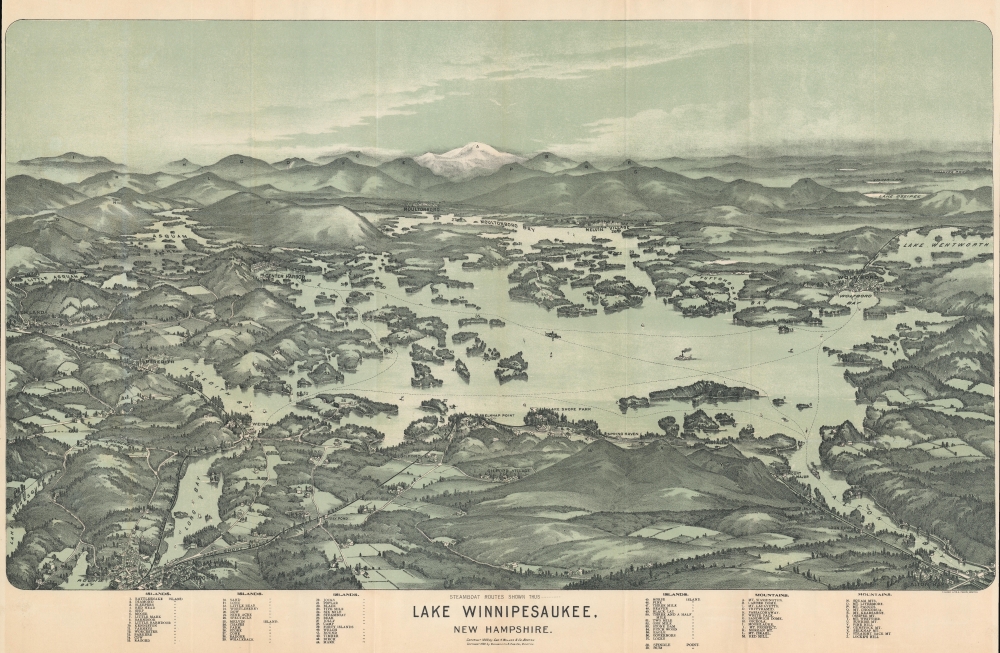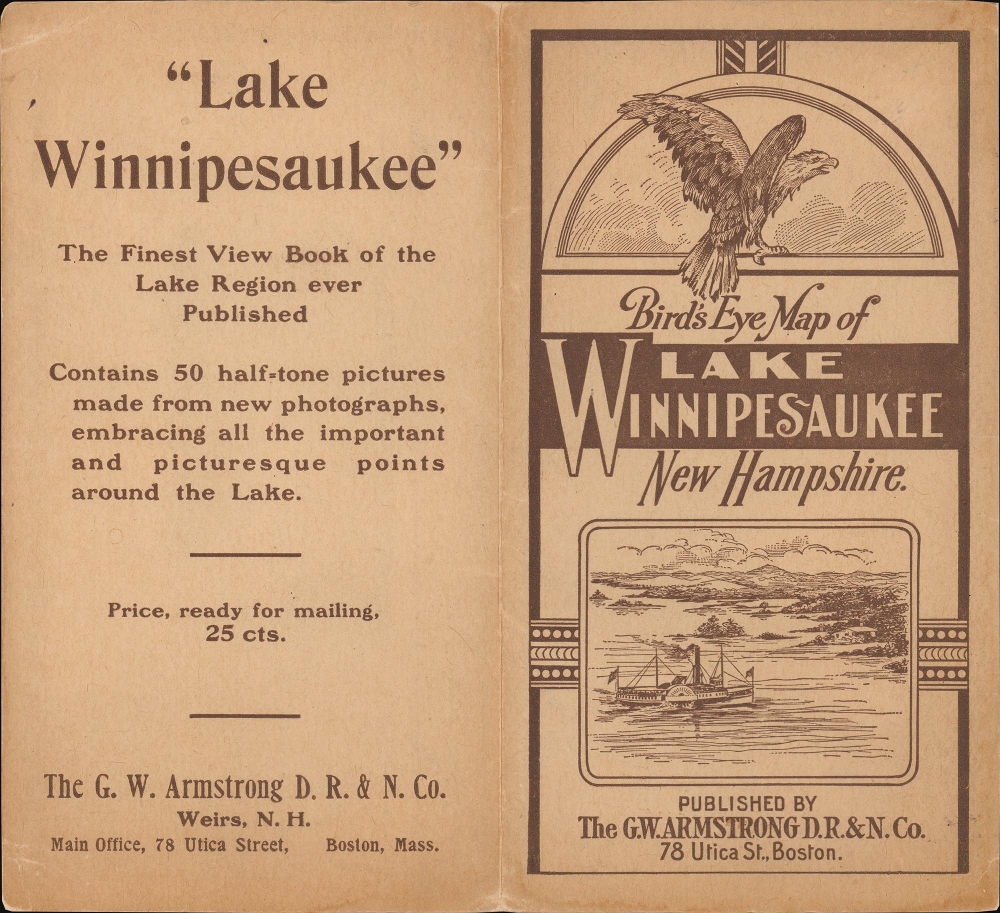This item has been sold, but you can get on the Waitlist to be notified if another example becomes available, or purchase a digital scan.
1909 Walker View of Lake Winnipesaukee, New Hampshire
LakeWinnipesaukee-walker-1909-2
Title
1909 (dated) 27 x 17 in (68.58 x 43.18 cm)
Description
A Closer Look
One of the more obscure and rare maps by George Walker, it covers the popular summertime destination from Little Asquam and Lake Winnesquam to Lake Wentworth and from Alton Bay and Round Bay to Moultonboro and Walkers Pond. The map includes many New Hampshire islands, towns, and bays, including Center Harbor, Asquam, Moultonboro, Wolfboro, Lake Wentworth, Lake Ossipee, Long Bay, Meredith Bay, Alton Bay, Round Bay, and others. The White Mountains appear in the background, centered around a snow-covered Mt. Washington. The foreground features houses and fields with sailboats and steamships plying the lake. Fifty-nine islands and twenty-six mountains are included as keyed references along the bottom margin. The map also shows major railway lines. It is accompanied by its original cover.Chromolithography
Chromolithography, sometimes called oleography, is a color lithographic technique developed in the mid-19th century. The process uses multiple lithographic stones, one for each color, to yield a rich composite effect. Generally, a chromolithograph begins with a black basecoat upon which subsequent colors are layered. Some chromolithographs used 30 or more separate lithographic stones to achieve the desired effect. Chromolithograph color can be blended for even more dramatic results. The process became extremely popular in the late 19th and early 20th centuries when it emerged as the dominant method of color printing. The vivid color chromolithography made it exceptionally effective for advertising and propaganda.Publication History and Census
This map was drawn and lithographed by George H. Walker in Boston. This is the second edition, published by the G. W. Armstrong Dining Room and News Co., Boston, Massachusetts. Four examples of the scarce 1909 edition are cataloged in OCLC: Columbia University, the State Library of Massachusetts, Dartmouth Library, and the Huntington Library.CartographerS
George Hiram Walker (January 4, 1852 - November 14, 1927) was a Boston based publisher of books, views, and maps active in the late 19th and early 20th centuries. Born in Springfield, Vermont, Walker started his life as a dry goods merchant but developed an active interest in publishing during the early 1870s. Walker began publishing in 1878 when he partnered with an unknown New York Firm. Two years later, Walker brought the operation in house by partnering with his brother, Oscar W. Walker, in the opening of a lithography studio at 81 Milk Street, Boston. Shortly thereafter the firm expanded to new offices at 160 Tremont Street, Boston. The Walker brothers produced a large corpus of works, most of which focused on travel and tourism in New England. Walker also established the Walker-Gordon Milk Laboratory with Dr. Thomas Morgan Rotch and Gustave Gordon. This interesting investment was based on the premise that infant deaths could be avoided by providing higher quality milk. The company eventually became a great success, producing a high-quality cow milk that closely resembled human breast milk. In the process the Walker-Gordon laboratory developed many of the dairy health standards that are still with us today. Walker married Irene L. Loud on March 25, 1885. More by this mapmaker...
George Washington Armstrong (August 11, 1836 - June 30, 1901) was an American businessman and newspaperman active in Boston and Maine from the mid 19th to the early 20th century. Armstrong was born in Boston, Massachusetts. His family were among the first Scottish settlers in New Hampshire in the early 1700s. He was educated at the Hawes Grammer School. In 1850, when Armstrong was just 14, his father died and, receiving 83 USD from the estate, he quit school and set out on his own. He initially took work as a penny postman covers South Boston. Later he became an office boy for the South Boston Gazette and Saturday News. Two years later, in 1852, he became a newsboy on the Boston- Worcester Line, a position he held for 9 years, and which defined much of his future. In 1863, he became half-owner of the restaurant and newsroom at the Boston station of the Boston-Albany Line (previously the Boston-Worchester). By 1871, he was the sole owner, operating as the 'G. W. Armstrong Dining Room and News Co.' Achieving considerable success in the news business, he launched Armstrong's Transfer, a goods and baggage transport service that utilized the trolleys and railroads. He expanded his newsroom business by acquiring all news and restaurant services entire Boston-Albany line, the Hoosac Tunnel Line, and the Eastern Railroad. He later diversified his holdings into bank and railroad stock. As part of his news business, Armstrong published a number of booklets, pamphlets, and maps for sale along the most popular routes he serviced. Later in life he divided his time between estates in New Hampshire and Florida. After his death the 'G. W. Armstrong Dining Room and News Co.' continued to operate for about 20 years. Learn More...




